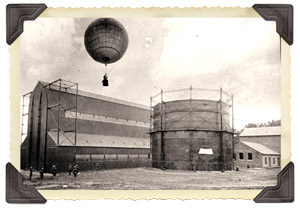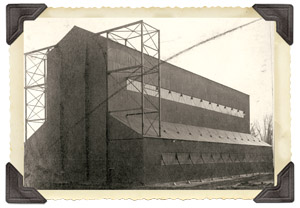Tour Stop E: Historical Account of Dirigible
After nine years of inactivity, Fort Omaha reopened in 1905 as a school for noncommissioned Signal Corps officers. A structure to house the Army's only dirigible (balloon airship) was completed in 1908, and the dirigible flew in April 1909. Four years later, all personnel and property were transferred to Fort Leavenworth.
 Under threat of world war, Fort Omaha was renovated in 1916 to house a Balloon School led by Captain Charles Chandler. In 1919, Florence Field, 119 acres about one-and-a-half miles north of Fort Omaha, was acquired for a subpost to provide space for more balloons.
Under threat of world war, Fort Omaha was renovated in 1916 to house a Balloon School led by Captain Charles Chandler. In 1919, Florence Field, 119 acres about one-and-a-half miles north of Fort Omaha, was acquired for a subpost to provide space for more balloons.
Balloon training demanded many hours of map reading, charting enemy installations and troop movements and refining methods to relay information. A telephone line from the balloon's basket connected observers to an extensive switchboard system. Using a code, balloonists could direct artillery battery toward enemy installations. Even though a fixed balloon was a prime target itself, 16,000 men enthusiastically trained at Fort Omaha during World War I.
 Because photoreconnaissance by airplane was still awkward and inaccurate, many types of observation balloons were tested at Fort Omaha. The Caquot, the best of the captive (stationary) balloons, was shaped like a sausage with trail fins to stabilize direction and a network of cables for tethering it to the ground.
Because photoreconnaissance by airplane was still awkward and inaccurate, many types of observation balloons were tested at Fort Omaha. The Caquot, the best of the captive (stationary) balloons, was shaped like a sausage with trail fins to stabilize direction and a network of cables for tethering it to the ground.
Visit the Knights of Columbus Assembly Hall…